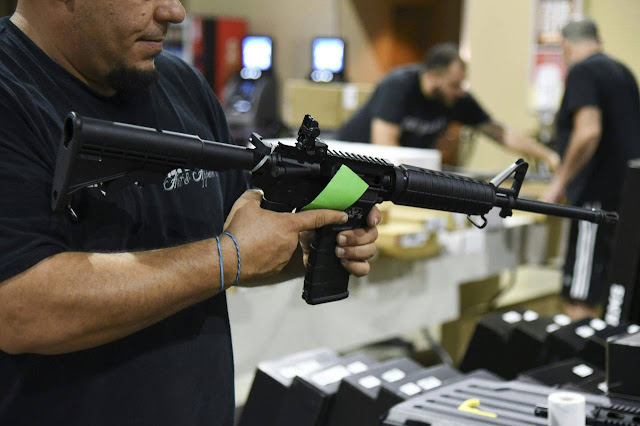 |
| The Florida school shooting has revealed not so much a national disagreement over guns or school violence, but rather an enormous cultural divide, of which guns are only the most obvious part. |
Trump’s Task: Bridge Cultural Divide on Guns. A president known more for dividing than uniting has an opening this week.
The Florida school shooting has revealed not so much a national disagreement over guns or school violence, but rather an enormous cultural divide, of which guns are only the most obvious part.
And who is in position to bridge that divide? President Donald Trump. He has been known more for dividing than uniting, so whether he’ll play this role or not remains to be seen.
But the opportunity is there. It’s an opportunity available more to a national leader trusted by gun owners and their organization, the National Rifle Association, than to one mistrusted by them. Perhaps this isn’t exactly a Nixon-to-China moment, but it’s close. The president will have his opening this week, when he is expected to meet with governors and lawmakers on gun issues.
The searing national debate since a suspect gunned down 17 students with an AR-15-style rifle is notable not because people on different sides disagree. That’s normal in American democracy. What’s striking is that people on opposing sides of this broader cultural chasm often can’t even conceive of how people on the other side can hold their positions.
Rarely has that been more clear than in aftermath of the disturbing speech delivered last week by Wayne LaPierre, the NRA’s chief executive, at the Conservative Political Action Conference. It was a speech framed almost entirely around the idea that gun owners are opposed by “them”—loosely defined as intellectuals, Democrats and the news media.
RELATED
Background-Checks Bill Hits Snags
Ex-Deputy Says He Believed Gunfire Was Outside Florida School
More Schools Seek Shooting Defenses
These elites “don’t care, not one whit, about America’s school system and schoolchildren,” Mr. LaPierre declared. Instead, he charged, they want to take advantage of the Florida school tragedy to take away the right to bear arms.
Taking away guns, he said, is simply the opening of a campaign to take away all individual freedoms: “Their goal is to eliminate the Second Amendment and our firearms freedoms, so they can eradicate all individual freedoms.” This threat is real, he argued, in part because the Democratic Party—whose presidential candidate won the votes of nearly 66 million Americans in 2016—now is “infested with saboteurs” who “don’t believe in our freedom.”
Mr. LaPierre’s outlandish rhetoric distracts from an important underlying reality: His basic argument—that the right to own guns is fundamental to other American freedoms—is one with which many gun owners agree. Indeed, a Pew Research Center poll last year found that three-quarters of gun owners considered the right to own a gun an “essential” right.
In contrast, many Americans on the other side of the gun debate can’t comprehend how fellow citizens could see it that way. To them, the right that is at stake is something more fundamental, the right to life, also enshrined in the Constitution.
This is a considerable gap, but hardly the only one in an America increasingly split between rural and urban, red states and blue states, North and South. A Wall Street Journal/NBC News poll last year explored this cultural gap, and found it both pervasive and growing.
The splits happen to be most visible along party lines. Asked whether they were concerned the government might go too far in restricting gun ownership or, conversely, that government wouldn’t do enough to regulate firearms, 77% of Republicans said they worried the government would go too far. By contrast, in a mirror-image share, 71%, of Democrats said they worried the government wouldn’t go far enough.
But it isn’t just guns. Democrats are eight times as likely as Republicans to favor action on climate change, for example. Nor is it just a partisan divide. Two-thirds of urban dwellers said they felt comfortable overall with societal changes that have made the U.S. more diverse. Meanwhile, just 38% of rural Americans felt that way.
One task of political leaders is to try to bridge such divides. But there hasn’t been much of that lately—and it’s hard in the aftermath of a 2016 election in which many Americans don’t merely disagree with those who voted for the candidate they opposed for president, but can’t even imagine how they could cast such a vote.
This is the problem, but also the opportunity, for Mr. Trump. In the current environment, it’s easier for a leader with credibility with NRA supporters to move the system toward action on guns—stiffer background checks, age restrictions on sales, bans on equipment that effectively turns rifles into machine guns.
In a White House meeting with families of gun victims, Mr. Trump ably directed the conversation toward broadly acceptable items on registration and age limits. Then, the next day, he delivered a red-meat speech to CPAC that focused more on arming teachers and seemed designed to move away from consensus. Was he reassuring gun owners before making moves they won’t like, or simply reassuring them? We’ll know more this week.
Write to Gerald F. Seib at jerry.seib@wsj.com
Appeared in the February 27, 2018, print edition.

No comments:
Post a Comment
Note: Only a member of this blog may post a comment.